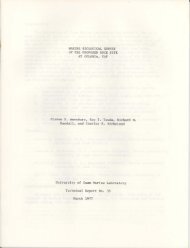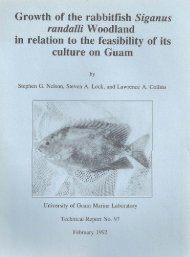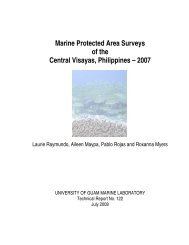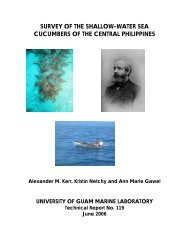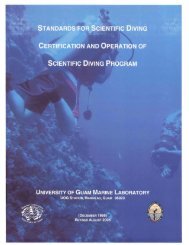Taxonomic inventories and assessments of terrestrial snails on the ...
Taxonomic inventories and assessments of terrestrial snails on the ...
Taxonomic inventories and assessments of terrestrial snails on the ...
You also want an ePaper? Increase the reach of your titles
YUMPU automatically turns print PDFs into web optimized ePapers that Google loves.
young. By mid-1954, <strong>the</strong> populati<strong>on</strong> <str<strong>on</strong>g>of</str<strong>on</strong>g> G<strong>on</strong>axis kibweziensis was estimated to be 80,800, while<br />
<strong>the</strong> Achatina fulica populati<strong>on</strong> was estimated to be 37,600 (Davis, 1954). Davis (1954)<br />
calculated approximately 60% effectiveness for G<strong>on</strong>axis kibweziensis, <str<strong>on</strong>g>and</str<strong>on</strong>g> more than 500<br />
G<strong>on</strong>axis kibweziensis were shipped to Hawaii for biological c<strong>on</strong>trol <str<strong>on</strong>g>of</str<strong>on</strong>g> Achatina fulica.<br />
Additi<strong>on</strong>al specimens from Aguiguan were sent elsewhere in Micr<strong>on</strong>esia (Peters<strong>on</strong>, 1957;<br />
Eldredge, 1988). Although no efforts to assess <strong>the</strong> threat <str<strong>on</strong>g>of</str<strong>on</strong>g> <strong>the</strong> introduced predator to<br />
indigenous l<str<strong>on</strong>g>and</str<strong>on</strong>g> <str<strong>on</strong>g>snails</str<strong>on</strong>g> were reported, K<strong>on</strong>do (1970) discovered a new species, Partula langfordi,<br />
living sympatrically with Partula gibba in Aguiguan during his field investigati<strong>on</strong>s in 1952.<br />
Some 30 years after <strong>the</strong> experiment began in Aguiguan to determine <strong>the</strong> effectiveness <str<strong>on</strong>g>of</str<strong>on</strong>g><br />
predatory c<strong>on</strong>trol <strong>on</strong> <strong>the</strong> invasive African snail, a team <str<strong>on</strong>g>of</str<strong>on</strong>g> scientists from <strong>the</strong> University <str<strong>on</strong>g>of</str<strong>on</strong>g> Guam<br />
found no living Achatina fulica or G<strong>on</strong>axis kibweziensis during a two-day survey in 1984 <strong>on</strong> <strong>the</strong><br />
western end <str<strong>on</strong>g>of</str<strong>on</strong>g> <strong>the</strong> lower terrace <str<strong>on</strong>g>of</str<strong>on</strong>g> <strong>the</strong> isl<str<strong>on</strong>g>and</str<strong>on</strong>g> (Eldredge, 1985). Similarly, Butler (1992)<br />
reported no live Achatina fulica were observed during an archaeological investigati<strong>on</strong> covering<br />
some 57% <str<strong>on</strong>g>of</str<strong>on</strong>g> <strong>the</strong> isl<str<strong>on</strong>g>and</str<strong>on</strong>g>. However, partulid tree <str<strong>on</strong>g>snails</str<strong>on</strong>g> persisted in Aguiguan, as evidenced by<br />
collecti<strong>on</strong>s by T. Pratt <strong>on</strong> February 2, 1985. Pratt collected 14 live tree <str<strong>on</strong>g>snails</str<strong>on</strong>g> (5 adult Partula<br />
langfordi <str<strong>on</strong>g>and</str<strong>on</strong>g> 7 adult Partula gibba, plus 2 unidentified juveniles) from “various trees <str<strong>on</strong>g>and</str<strong>on</strong>g><br />
shrubs <strong>on</strong> <strong>the</strong> west end <str<strong>on</strong>g>of</str<strong>on</strong>g> <strong>the</strong> isl<str<strong>on</strong>g>and</str<strong>on</strong>g>,” <str<strong>on</strong>g>and</str<strong>on</strong>g> he deposited <strong>the</strong>m in <strong>the</strong> synoptic invertebrate<br />
collecti<strong>on</strong>s at <strong>the</strong> University <str<strong>on</strong>g>of</str<strong>on</strong>g> Guam Marine Laboratory (Lot No. UGI 6019).<br />
Partulids were again recorded at Aguiguan by two independent survey groups in 1992.<br />
In May, 1992, a team <str<strong>on</strong>g>of</str<strong>on</strong>g> scientists <str<strong>on</strong>g>and</str<strong>on</strong>g> students from <strong>the</strong> Nor<strong>the</strong>rn Marianas College observed<br />
tree <str<strong>on</strong>g>snails</str<strong>on</strong>g> at three locati<strong>on</strong>s (sites numbered 1, 3, <str<strong>on</strong>g>and</str<strong>on</strong>g> 7 <str<strong>on</strong>g>of</str<strong>on</strong>g> <strong>the</strong> present study, Figure 3) al<strong>on</strong>g <strong>the</strong><br />
western slope <str<strong>on</strong>g>of</str<strong>on</strong>g> <strong>the</strong> isl<str<strong>on</strong>g>and</str<strong>on</strong>g> (Craig <str<strong>on</strong>g>and</str<strong>on</strong>g> Ch<str<strong>on</strong>g>and</str<strong>on</strong>g>ran, 1992). Snails identified as Partula gibba were<br />
encountered <strong>on</strong> trees in native <str<strong>on</strong>g>and</str<strong>on</strong>g> sec<strong>on</strong>dary forest. No snail counts or populati<strong>on</strong> estimates<br />
were given.<br />
A sec<strong>on</strong>d survey in November, 1992, by a team <str<strong>on</strong>g>of</str<strong>on</strong>g> scientists from <strong>the</strong> CNMI Divisi<strong>on</strong> <str<strong>on</strong>g>of</str<strong>on</strong>g><br />
Fish <str<strong>on</strong>g>and</str<strong>on</strong>g> Wildlife <str<strong>on</strong>g>and</str<strong>on</strong>g> <strong>the</strong> University <str<strong>on</strong>g>of</str<strong>on</strong>g> Guam, resulted in observati<strong>on</strong>s <str<strong>on</strong>g>of</str<strong>on</strong>g> three living tree <str<strong>on</strong>g>snails</str<strong>on</strong>g>,<br />
two Partula gibba <str<strong>on</strong>g>and</str<strong>on</strong>g> <strong>on</strong>e Partula langfordi (Smith, 1995). Observati<strong>on</strong>s <str<strong>on</strong>g>of</str<strong>on</strong>g> both species were<br />
made <strong>on</strong> <strong>the</strong> 50-m terrace <str<strong>on</strong>g>of</str<strong>on</strong>g> <strong>the</strong> northwest coast. Partula gibba, <strong>on</strong>e adult <str<strong>on</strong>g>and</str<strong>on</strong>g> <strong>on</strong>e juvenile,<br />
were found <strong>on</strong> leaves <str<strong>on</strong>g>of</str<strong>on</strong>g> Mammea odorata al<strong>on</strong>g <strong>the</strong> terrace edge at Site 7 <str<strong>on</strong>g>of</str<strong>on</strong>g> <strong>the</strong> present study<br />
(Figure 2). Partula langfordi occurred <strong>on</strong> Guamia mariannae, <strong>on</strong> a leaf some 3 m above <strong>the</strong><br />
ground at Site 6 <str<strong>on</strong>g>of</str<strong>on</strong>g> <strong>the</strong> present study (Figure 3). Although a case could be made for <strong>the</strong><br />
introducti<strong>on</strong> <str<strong>on</strong>g>of</str<strong>on</strong>g> goats in Aguiguan around 1818 as <strong>the</strong> initial step in <strong>the</strong> decline <str<strong>on</strong>g>of</str<strong>on</strong>g> <strong>the</strong> native<br />
<str<strong>on</strong>g>snails</str<strong>on</strong>g>, partulids had persisted with <strong>the</strong> goats for more than 170 years.<br />
Results <str<strong>on</strong>g>of</str<strong>on</strong>g> <strong>the</strong> surveys in Aguiguan in 1992 suggested that tree snail populati<strong>on</strong>s had<br />
declined markedly in range <str<strong>on</strong>g>and</str<strong>on</strong>g> abundance. K<strong>on</strong>do (1970) reported <strong>on</strong> six col<strong>on</strong>ies <str<strong>on</strong>g>of</str<strong>on</strong>g> partulids<br />
inhabiting “open forest, <strong>on</strong> native plants predominantly Aglaia” in <strong>the</strong> vicinity <str<strong>on</strong>g>of</str<strong>on</strong>g> Site 1 <str<strong>on</strong>g>of</str<strong>on</strong>g> <strong>the</strong><br />
present study, i.e., “1000 yards nor<strong>the</strong>ast <str<strong>on</strong>g>of</str<strong>on</strong>g> <strong>the</strong> Boat L<str<strong>on</strong>g>and</str<strong>on</strong>g>ing... altitude 200 feet.” Nine<br />
additi<strong>on</strong>al col<strong>on</strong>ies were sampled <strong>on</strong> <strong>the</strong> north <str<strong>on</strong>g>and</str<strong>on</strong>g> west coasts <str<strong>on</strong>g>of</str<strong>on</strong>g> <strong>the</strong> isl<str<strong>on</strong>g>and</str<strong>on</strong>g>.<br />
Evidence <str<strong>on</strong>g>of</str<strong>on</strong>g> <strong>the</strong> former abundance <str<strong>on</strong>g>of</str<strong>on</strong>g> tree <str<strong>on</strong>g>snails</str<strong>on</strong>g> in Aguiguan was reported by Smith<br />
(1995), who noted numerous dead shells <str<strong>on</strong>g>of</str<strong>on</strong>g> both partulid species littering <strong>the</strong> ground, as well as<br />
25





